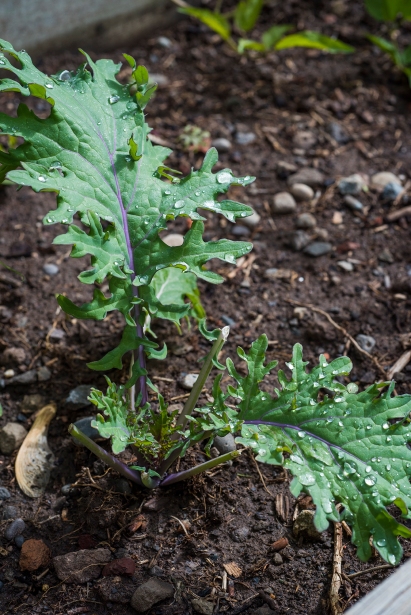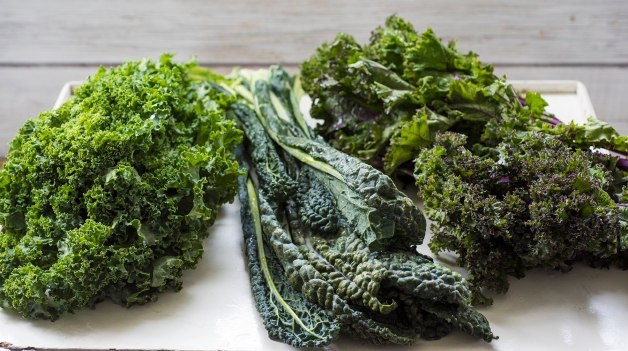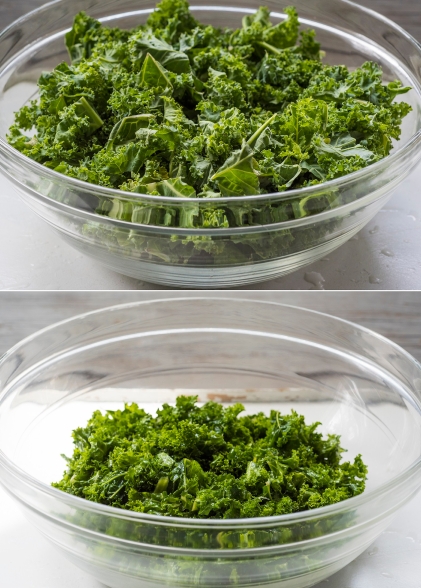Kale had a moment a few years back; it was suddenly – without warning – on every restaurant menu and in every recipe. It was as though kale had just been invented. Now, of course, it’s been supplanted as the trendy vegetable du jour – first by Brussels sprouts, and now by cauliflower. (I sincerely wish I’d invented “cauliflower rice;” the mark-up on those plastic packages – just for throwing it in a food processor! – is shocking.)

There are lots more varieties of kale than just what you see in the supermarket.
Like most Americans, I first encountered kale when I worked in the catering industry. Curly kale is so often a garnish on salad bars and buffets that we think of it more as decoration than vegetable. But its very hardiness – its ability to sit out on a buffet table for hours on end no matter the temperature, without wilting, is precisely what makes it so valuable both in the garden and in the kitchen.

‘Red Russian’ kale sprouts with their first true leaves.
I simply adore kale. I adore its sharp, almost metallic taste. I adore its indestructibility. I adore its versatility. And I adore its substantial nutritional benefits most of all. (Numerous studies have positively linked higher brassica consumption with lower cancer risk.) Kale is one of the first greens to appear in the spring, and one of the last to disappear when winter stomps in – and it often outlasts winter! It starts easily from seed or transplant, can be grown in virtually any soil, survives frost, heat, wind, snow, drought and neglect, and is one of the most nutrient-dense foods on the planet. It’s even inexpensive if you’re buying it at the store rather than growing it. If there is one thing you should add to your garden and your diet, it’s kale.

One of our kale plants after a recent rainstorm.
The kale we know and love today is part of the Brassica family, along with broccoli, cauliflower, and many others. It’s related to wild cabbage, and probably originated in the eastern Mediterranean and Asia Minor. Kale is one of our oldest-known cultivated crops, and today is a staple food in many cold-weather countries (eastern Europe and Russia, in particular) because it tolerates frost so well. As with most vegetables, your local supermarket probably only stocks one or two types of kale. Three, if you’re lucky. And these are all perfectly fine, and will work in any recipe you’re making. Just know, however, that if you want to sample more exotic kales, a good seed catalog might have dozens you can try.

Most commonly found in grocery stores, from left: standard curly kale, lacinato (or dinosaur) kale and red kale.
When I prepare kale, I always separate the leaves from the stems. There are – of course! – silly gadgets you can buy to accomplish this, but you can also just hold the stem with one hand whilst stripping the leaves with the other. I cook the stems, because they’re a bit tough to eat raw; chopped finely, they’re ideal in soups or stir-fries. The leaves, however, can be used either fresh or cooked, depending on the weather, your mood, and what you’re serving.

The same quantity of kale raw (top) and post-massage (bottom).
If I’m serving kale in a salad, I slice the leaves thinly and give them an aggressive massage. This means tossing the leaves in a bowl and sprinkling with good olive oil, lemon juice, salt and pepper, then using both hands forcefully to macerate the leaves. This massage makes the leaves easier to eat – so much less prickly! – and easier to digest, too. (Always use a bit of citrus with any dark, leafy greens; the extra vitamin C helps your body absorb the abundant iron.) Let the greens sit for ten or so minutes after their spa treatment; the quantity will have decreased substantially, but the salad will be much more delicious.

A recent supper for a chilly evening: white bean and kale soup with buttermilk biscuits.
Kale greens also love soups, stir-fries, pastas and any sort of one-pan mash-up meal. Kale is particularly fond of beans and potatoes and eggs, and can easily disappear into a smoothie. You can make tasty kale chips with a dehydrator or a low oven, or you can puree it with nuts and cheese for pesto. Because it holds up as a salad green, even when dressed, you can prep your healthy work lunches in advance. It’s loaded with fiber, vitamin A, zinc and magnesium and lots more nutrients, and has a surprising amount of protein for a vegetable. Really, there’s almost nothing this sharp, prickly, difficult-to-love-but-oh-so-worth-it vegetable can’t do. Just give it a chance.

My favorite kale salad with golden beets, Honeycrisp apples and Parmigiano-Reggiano.
My forever favorite way to eat kale raw is a riff on Chef Steve Redzowski’s famous kale and apple salad, from his restaurant Oak at Fourteenth. The original calls for thinly sliced kale, shaved Honeycrisp apple, delicate curls of Parmigiano-Reggiano, candied almonds and a sprinkle of the Japanese seasoning nanami togarashi, made up of black and white sesame seeds, citrus zest and chile powder. (You can make your own, or seek it out at any well-stocked Asian market. It keeps forever, and once you start using it on vegetables you’ll wonder how you cooked without it.) Of course, that’s just a jumping-off point. As with most recipes, make it the way you like it – or even better, make a “Clean Out the Fridge” Kale Salad and use up all your odds and ends.
Do you grow and eat kale? What varieties do you grow? How do you prepare it? Do you eat it because you actually like it or just because you know it’s good for you?
Kale in the garden, of course! Along with purple broccoli, cabbages and many other greens. Love a lemony, cold kale salad and one of our favorite winter soups has hot Italian Sausage with white beans and kale. Also a spicy Asian salad with cabbage, peppers, carrots and almonds (Maggie’s recipe).
Leeks are coming along nicely this season and we are harvesting heads of leafy lettuce. Love the rewards of the garden!!
LikeLike
Nancy, those kale ideas sound delicious! I wish we had leeks here but perhaps next year; I love anything in the allium family. We have our first salad greens now too – so late because of our cold, damp spring!
LikeLike
My favorite kale: Smooth German Kale. Found seeds from Seed Savers Exchange last year, also from Snake River Seeds this year. A good spring kale because in bolts in about 100 days, which means you can save seeds the first year. Yes, on the sausage, beans, and kale soup!!! With the night temps will we ever get warm season crop in before first frost?
LikeLike
Jim, I hope you noticed your ‘Smooth German’ seed packet in the first photo; thanks for sharing those! I’m excited to grow that variety this year and hopefully save seeds from it, too. Our overnight lows are in the mid 30s this week – it’s going to be a short growing season here.
LikeLike
Just curly kale in the garden so far. But anything that grows during winter will be tried next. My husband uses it in his smoothies but a favorite is the Kale Caesar from you! I also saute’ with little oil, butter, and white wine. The more I eat it the more I like it!
LikeLike
Hi Susan! That kale caesar is a great recipe – thanks for reminding me as I’ll make it soon. I love hearing comments like “the more I eat it the more I like it” because enjoying kale really does take a little adjustment phase.
LikeLike
Lately I have been loving “baby kale” it looks kind of like spinach leaves and is very mild. I hope it’s actually a real variety of kale and not just a marketing gimmick?
LikeLike
Hi Kelly! You’ll be pleased to know that “baby kale” is still actually kale…they’re just immature leaves, harvested before they develop a stronger flavor. Not a marketing gimmick like “baby carrots,” which are of course just regular carrots put into a food lathe so they come out with rounded edges. If you’re growing kale at home, you can harvest the leaves when they’re small so that they’re a little milder in flavor.
LikeLike
Pingback: Farm update: June 3 | Finding Quiet Farm
After 3 years of planning, I finally got my raised boxes built and a bunch of things planted in them. I planted a row of Red Russian kale along with Olympia spinach, lettuce blend, arugula, and French Breakfast radishes in one box and the other has Rainbow carrots and 2 different varieties of tomatoes. This is my first time gardening and so far, everything is coming up beautifully, including the kale!! I’ve already harvested a bunch to add into my salads as well as making some kale chips. Initially, I planted it because I knew it was healthy for me but it’s slowly grown on me to where I’m really starting to like it! I’ll be trying out some of the things in you blog for sure. Gardening gives me such peace and a sense of accomplishment along with making me feel so good that I know exactly where my food came from and that it wasn’t treated with anything that would harm me or the little insects that are so beneficial.
LikeLike
So excited to hear about your first garden, Becca! It’s unbelievably satisfying to know where your food comes from. Wishing you much continued success with your raised beds. Thanks for reading!
LikeLike
Pingback: You can pickle that | Finding Quiet Farm
Pingback: Farm update: July 20 | Finding Quiet Farm
Pingback: The zucchini chronicles | Finding Quiet Farm
Pingback: An ode to citrus | Finding Quiet Farm
Pingback: Farm update: July 26 | Finding Quiet Farm